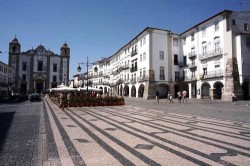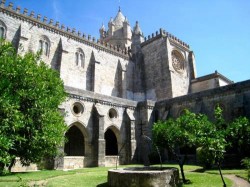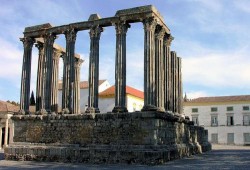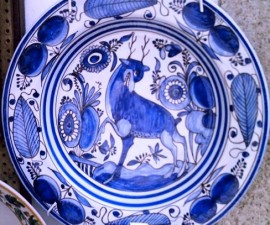The UNESCO World Heritage city of Évora offers many attractions for visitors to enjoy. There is plenty to keep visitors entertained for several days in the city, however if you in Évora for just one day there is a surprising amount that you can see and do.
As Évora has evolved and grown from a small, walled town first established in Roman times, its primary attractions have remained centrally located, clustered mostly in and around the ancient citadel that occupies its highest point, presiding over the maze of winding streets and historic buildings below.
Walking through the streets of Évora is like taking a walk through history. The town is something of a living, breathing museum celebrating Portugal’s rich and diverse history of conflicts and conquests, exploration and independence.
Praça do Giraldo
 The lively Praça do Giraldo is the perfect place to start any tour of Évora. The square is flanked on all four sides by a series of historic buildings dating back several centuries, and in some cases more than 2000 years. Here you will come across some of the most impressive examples of Gothic and Romanesque architecture to be found anywhere on the Iberian Peninsula, a collection of ecclesiastical buildings and ancient palaces, clustered around the lovely pedestrianised cobbled central area and fountain.
The lively Praça do Giraldo is the perfect place to start any tour of Évora. The square is flanked on all four sides by a series of historic buildings dating back several centuries, and in some cases more than 2000 years. Here you will come across some of the most impressive examples of Gothic and Romanesque architecture to be found anywhere on the Iberian Peninsula, a collection of ecclesiastical buildings and ancient palaces, clustered around the lovely pedestrianised cobbled central area and fountain.
The Praça do Giraldo is the perfect place to relax over a drink or bite to eat at one of its many cafes and bars. If you are staying in self-catering accommodations or if your hotel does not include breakfast, start your sightseeing day here with a leisurely breakfast in the sun at one of the outdoor tables of the pavement cafes. There is nothing quite like the strong aroma of freshly brewed Brazilian coffee beans and a Portuguese “pastel de nata” (a type of mouth-wateringly delicate custard tart) to get your day of historical explorations off to a flying start.
Temple of Diana
The ruins of the Roman Temple of Diana are located on one edge of the square, dating back some 2000 years to the days when Évora was one of Portugal’s most important Roman military outposts. Diana was the goddess of the moon, the hunt and chastity in ancient Rome and the temple was dedicated to her upon its construction in 100AD.
Historians believe that there would have been other similar temples built in the city around the same era, however if this is the case there is little surviving evidence of them now. The Temple of Diana is exceptionally strong, no doubt the reason for its survival as the devastating earthquake of 1755 razed many similar buildings to the ground. The Temple of Diana has had many uses throughout the ages, from execution site during the Inquisition to slaughterhouse in the nineteenth century.
Évora Cathedral
 Heading up the square away from the Temple of Diana, you will reach Évora Cathedral, an attractive combination of Gothic and Romanesque architecture. Évora Cathedral is set at the very highest point of the old citadel, in a dominant position presiding over the winding streets of the city below. It boasts an impressive facia of rose granite, which is capped either side by two huge towers dating back to the sixteenth century.
Heading up the square away from the Temple of Diana, you will reach Évora Cathedral, an attractive combination of Gothic and Romanesque architecture. Évora Cathedral is set at the very highest point of the old citadel, in a dominant position presiding over the winding streets of the city below. It boasts an impressive facia of rose granite, which is capped either side by two huge towers dating back to the sixteenth century.
Évora Cathedral is equally impressive inside as it is out. The ornate interior is a study in period opulence, boasting detailed frescoes, impressive sculptures and plenty of pink, black and white marble and stonework. Take a walk through the Gothic cloister to the open terrace to enjoy the sweeping views out across the Alentejo countryside before finishing up in the cathedral’s Museum of Sacred Art in the south tower.
Chapel of Bones
 Still in the heart of the UNESCO World Heritage site that covers much of the old town, you will arrive at St Francis Church and its famous Chapel of Bones. The St Francis Church is a fine example of late-fifteenth and early-sixteenth century architectural styles. However, its period architecture is not the only reason for visiting the church.
Still in the heart of the UNESCO World Heritage site that covers much of the old town, you will arrive at St Francis Church and its famous Chapel of Bones. The St Francis Church is a fine example of late-fifteenth and early-sixteenth century architectural styles. However, its period architecture is not the only reason for visiting the church.
The Chapel of Bones was created by a group of Franciscan monks in an effort to free up some of the surrounding land, which was at the time taken up with no less than 42 different consecrated burial sites. Rather than bury the remains anew, the monks cemented them into the walls of the chapel as a reminder of their own mortality and a place for contemplation and prayer.
There are many other historic attractions to see and enjoy in Évora, many of which, such as the Agua de Prata Aqueduct and the castle walls can be admired simply by wandering through the winding streets of the old town. The Agua de Prata Aqueduct stretches for nine kilometres from its source right through the centre of town, and is one of Portugal’s most impressive architectural works of the sixteenth century, while the old castle walls can be admired at every turn, the perfect reminder of Évora’s rich, historic past.



